The Abbey Fields Outdoor Pool (Published online in August 2018)
With the future of the 120 year-old outdoor pool in the Abbey Fields seriously in doubt, it is time to look back on its history.
There has always been swimming in the Abbey Fields, even before it became the town’s park.
In the days before mains water, and when the brook was several feet deep on a normal day, it was used by youths for bathing; perhaps the earliest recorded example was in the early 1840s when a very young William Holmes “was chased home in my original birthday suit” from the Abbey Fields to his New Street home; it was likely to have been a very well established pastime.
It was hoped that the Earl of Clarendon, who owned the fields, would allow a proper bathing place to be made, but he declined. On 12th May 1884, the Kenilworth Local Board bought the central 40 acres of the fields from Clarendon to provide recreational facilities for the town; it was thought that a swimming pool of some sort would quickly be provided but it did not materialise. The continuing ‘not particularly decent’ antics of youths bathing often resulted in calls for a swimming baths and a number of sites were looked at away from the park.
In 1894, the Kenilworth Urban District Council was formed and in its manifesto the Liberal Party promised a commitment to building the baths, and all 8 of its candidates were subsequently elected. The pool was excavated and virtually completed in the summer of 1895 but difficulties with the water supply saw the opening delayed until Monday 1st June 1896. The 60,000 gallon unheated pool was about 75ft by 35ft and varied in depth from 2ft 6” to 5ft. The aforementioned William Holmes was said to be the first person in the pool. On the first day 119 men and 9 boys swam; mixed bathing was not allowed, who and when the first ladies used the facilities has not been recorded but they were allocated 5 hours on Tuesdays. The final cost of building the pool was £470, the equivalent of £57,000 today.
Although initially popular, its use quickly waned, and by the early 1900s perhaps only 1,000 people used it each year. In 1900 only two ladies were recorded, and so the following year no sessions were allocated for female swimmers.
The formation of a swimming club in 1904, created mainly to teach youngsters to swim, turned the fortunes of the pool, and at their first gala attracted an appearance by James Arthur Jarvis, the self-styled ‘Swimming Champion of the World’ who was the first ever triple Olympic Champion.
In 1925, the swimming club requested that mixed bathing be allowed for its members on certain occasions; this was granted provided every male was accompanied by a lady! After a petition had been organised, it was probably the Whitsun weekend of 1927 that mixed bathing for the public was allowed for the first time.
By 1930, its popularity saw the pool regularly crowded to dangerous proportions, but successive hot summers also saw the quality of the water, taken straight from the brook alongside, decline. At the end of 1934 the pool closed in the interest of public health. It was decided to completely rebuild the pool and install proper filtration and water-treatment for the first time.
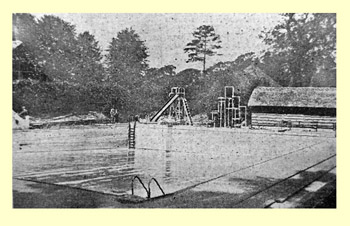 |
The new pool was a similar length to the old but its width was doubled; it was also raised 3ft due to the water-pressure problems, leaving the original pool-floor in situ (see diagram below). |
New changing rooms were constructed at each end in the same thatched style of the (still surviving) tennis and bowls pavilion. Diving boards and shutes were installed, as was a cascade water-aerator, but it was still unheated. From the closure of the original pool, the decision making, planning, fund allocating and execution of the new took only 9 months. It was often referred to as a ‘lido’; had it been officially called the Kenilworth Lido when it opened on 15th July 1935, it would have been the first in the country.
The pool’s popularity post war saw plans drawn up for its development in September 1960. This resulted in new changing rooms, entrance, and kiosk in the Spring of 1965, set well in to the park and creating space on the bowling green and church sides of the pool for potential future developments including a much-talked about indoor pool. The plinths on which sat the 1930s changing rooms were kept at each end for terracing.
Following a campaign led by the Kenilworth Swimming Club started in July 1968, funds were raised by the swimming public to provide pool-heating. The KUDC was initially sceptical, as it was they that would have to pay for its upkeep, but eventually accepted the inevitable and with a cheque for £1,769 (the equivalent of about £25,000 today) handed over, the pool with its new heating equipment re-opened on 23rd May 1970.
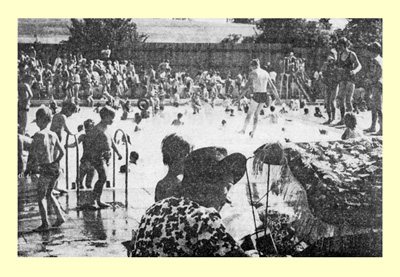 |
The pool, already popular, had in increase in usage, particularly in the school summer holidays; overcrowding became a problem and after a safety inspection numbers had to be limited – to 400 at a time! Often queues formed and extra session breaks had to be introduced. The pool effectively became the town’s social centre for children, a place to meet school and other friends, and relatives, during the holidays. |
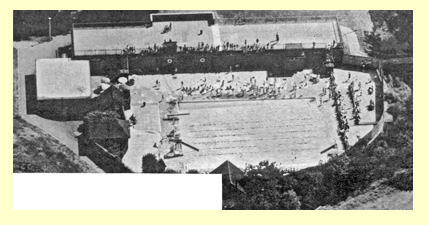
The pool with its new changing rooms showing the space for expansion left around it.
The plan for an indoor pool was revived by the Warwick District Council, just a few years after its formation in 1974. The outdoor pool was to be reshaped from its rectangular form, and also reduced in its depths to greatly reduce the amount of water that needed heating. A toddlers’ pool was also built; both were built within the existing pool which was partially in-filled. The changing rooms were altered and new ones rebuilt, and a larger internal cafe provided. The new pool opened for the public on 8th October 1986
The pool today incorporates structures from many eras. The 1985 built cafe, foyer and men’s changing rooms incorporate much of the brick work from 1965. The public toilets accessible from the Abbey Fields were built in 1971/2. It is probable that all previous outdoor pools survive to an extent as each was built inside the then existing one; much of the surrounding paving is likely to be from the 1930s, and the terracing at the brook end was built as the plinth for changing rooms in 1935.
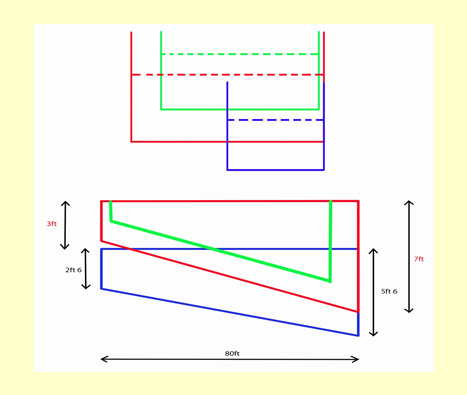
Diagram showing the arrangement of the three pools built inside one another. Blue for the original pool, red for the 1935 pool, and green for the 1985 pool. The dotted lines represent the depth of the shallow end. It is known that the 1935 pool survives more or less intact, and parts of the 1896 are likely to survive beneath it.
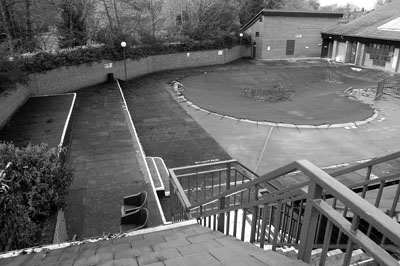
The outdoor pool today; the terracing dates from the 1935 ‘Lido’.
(The text is adapted from The Abbey Fields in which a fully detailed account of the pool’s history with additional photographs can be found.)
Update, March 2023:
This is a photo of the 1896 swimming pool, the date is unknown. It shows how the pool sat low in the ground with banks around it, party constructed with material excavated from the pool. As predicted above, parts of it did indeed still survive below the other pools, and was rediscovered in 2023: 2023 b, the 1896 swimming pool
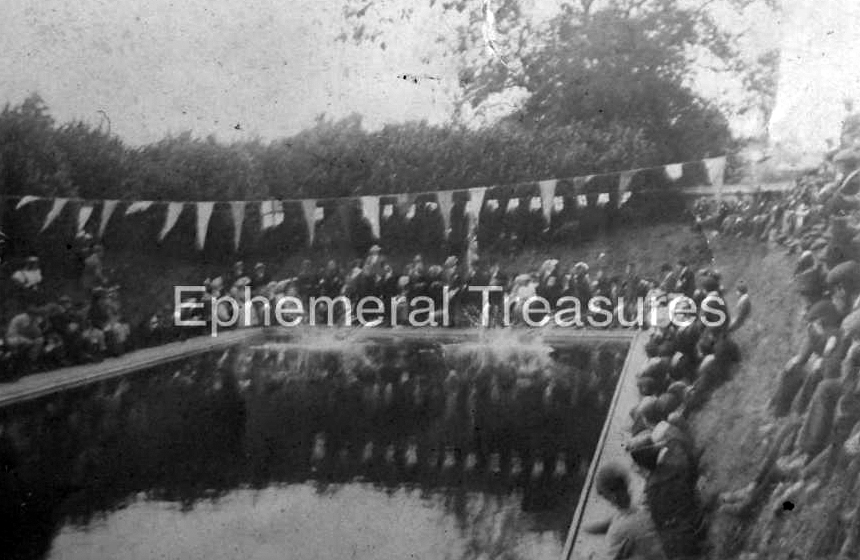
This is looking in a very similar direction to the photograph at the top of the page; note that the hedges around the bank were retained, giving an indication as to how much higher in the ground the 1935 pool was.
More Abbey fields articles:
How the land was acquired Full details on how each plot became part of the park between 1884 and 1974.
The Covenants Each plot came with a covenant and restrictions
Abbey Fields Cycle Path Always under discussion, a complete record of attempts for cycling to return to the park
Car Parking in the Abbey Fields How the car park came about
Bye-laws The non-observance of bye-laws is often discussed, here you can see them all
Abbey Fields Archaeology A guide to the many archaeological explorations of the Abbey and its surroundings from 1840 to the present day
Abbey Fields Play Equipment Some aspects of the park play equipment, now established over a century
Abbey Fields, 1947 A look at the park as it appeared in the national aerial record of 1947
Abbey Fields Timeline A chronology of the Abbey Fields starting in the ice age!
Abbey Fields Swimming Pool, a photographic survey, 1960-2023
Return to Abbey Fields home page
See also my book: